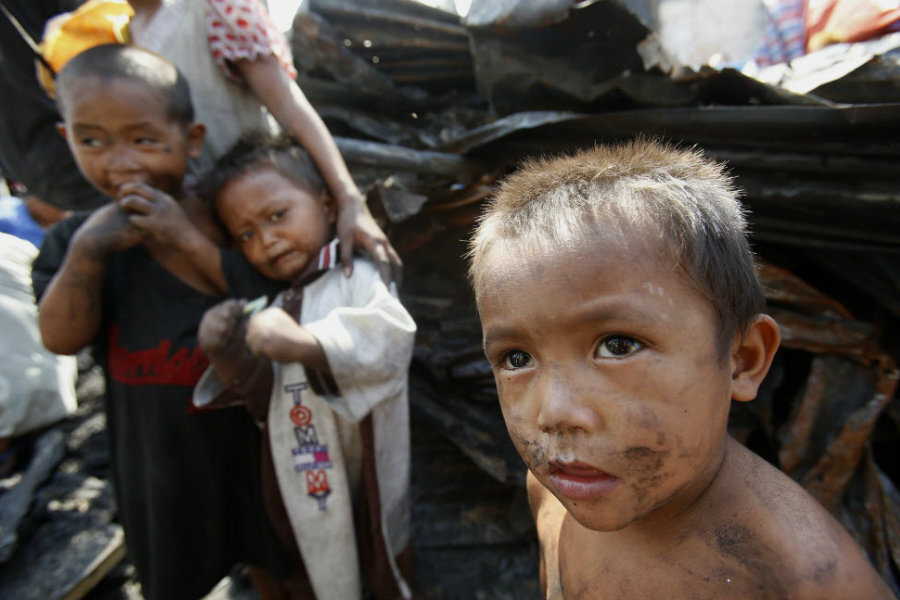Some 10,000 left homeless after Manila shanty town fires
Loading...
About 10,000 families in the Philippines were displaced after two fires broke out less than a day apart in downtown Manila Tuesday, according to multiple reports.
The fires underscore the need for both immediate and long-term solutions to the risk of fires in the poorest areas of Manila and other urban spaces in developing countries – a problem that was highlighted in a 2010 Red Cross report.
The first fire swept through one end of the Parola Compound – a shanty town in the densely-populated Tondo community – around 6 p.m. Monday night, and spread quickly as winds from nearby Manila Bay fanned the flames, China state news agency Xinhua reported.
The blaze burned for 12 hours and destroyed nearly 5,000 homes before firefighters put it out early Tuesday morning, Reuters reported.
A second fire, starting at another end of the same compound around 1 p.m. Tuesday afternoon, razed another 50 homes before being put out two hours later, according to Philippine media outlet ABS-CBN News.
So far, three people have been reported injured, including one firefighter. Investigations into the causes of both fires are reportedly underway.
The back-to-back fires are the latest in a tally of more than 600 to have broken out in Manila in January and February alone, the Philippine Bureau of Fire Protection reported. Eighteen people have been killed and 46 injured in those fires, according to the same report.
Problems with electrical lines, often located in crowded, low-income parts of the city, have been the top cause of the fires; others include lighted cigarettes and unattended fire sources, such as cooking stoves and candles.
The Philippine government – hoping to lower the incidence of fires during the hot summer season, which lasts until May – declared March Fire Prevention Month, with activities lined up on fire safety and awareness.
Efforts for the month include greater fire truck visibility, a house-to-house and media fire safety information campaign, and a no-leave policy that applies to all Bureau of Fire Protection personnel. Contests for students and professionals will be held to promote fire safety knowledge, and a three-day open house for all fire stations in the city will be held mid-month.
Still, at least four fires, including those in Tondo, have already broken out in different parts of the capital since March 1, according to reports.
Urban poverty and disaster risk “are often closely intertwined,” according to a 2010 report by the International Federation of Red Cross and Red Crescent Societies. (The Philippine National Statistics Coordination Board estimated that almost 28 percent of Filipinos lived below the poverty line in 2013.)
High land prices in urban areas in low- and middle-income nations lead to illegal settlements on dangerous sites that lack proper infrastructure and services. Hazardous, overcrowded housing – such as in the case of the Parola Compound – make it difficult for firefighters to battle such fires.
When fires strike, low-income survivors are often prevented from moving back into their old settlements and rebuilding their homes and livelihoods, according to the report.
In Manila, for instance, the Philippine Social Welfare Department and Development has been providing food and supplies to Tondo’s displaced families, many of whom are temporarily being housed in a local gymnasium.
"We need help,” one survivor told Reuters. “We have nowhere to sleep and nowhere to go. Everything has gone. I do not have anything except some clothes I saved for my child.”
The city government has also been helping to feed the displaced, and Manila mayor Joseph Estrada has reportedly called on the local business community for their support. Some private foundations, such as local network TV 5's Alagang Kapatid ("a brother's care"), have begun to send aid as well.
There is no single, sweeping solution to preventing fires and rebuilding, and housing reconstruction in low-income urban areas is far easier said than done. In Chile, for instance, the government and local residents are still recovering from a fire that killed 15 and destroyed nearly 3,000 homes in the port city of Valparaiso in April last year.
In the days following the disaster, Chilean president Michelle Bachelet vowed to rebuild the historic city. But forest fires erupted in the same area in December, and the region of Valparaiso remains a red alert zone today, even after the United Nations supported a $510 million reconstruction plan, Fox News Latino reported.
The IFRC insists that fire prevent efforts must begin at the community and city levels.
“[Low-income communities] need effective local institutions that are accountable to citizens including those living in informal settlements,” according to the report. “Where city and municipal governments have sufficient capacity, focus on their low-income households and have good relations with their citizens, the possibilities for disaster risk reduction are greatly enhanced.”
One group that has been involved in building and improving communities at the local level is the nonprofit Gawad Kalinga ("give care"), which has long focused on empowering and bringing a sense of dignity to the underprivileged. Through a network of volunteers, the group collects donations, builds houses, and interacts with the residents of some of the country's poorest communities.
"In GK, everyone is welcomed not as a donor but as a key stakeholder… a committed and passionate partner in re-building the nation," Gawad Kalinga's site reads. "GK breaks the current culture of individual gain and instead envisions a strong united community that builds together, plants together, harvests together and rises together – believing that no one will be left behind."








